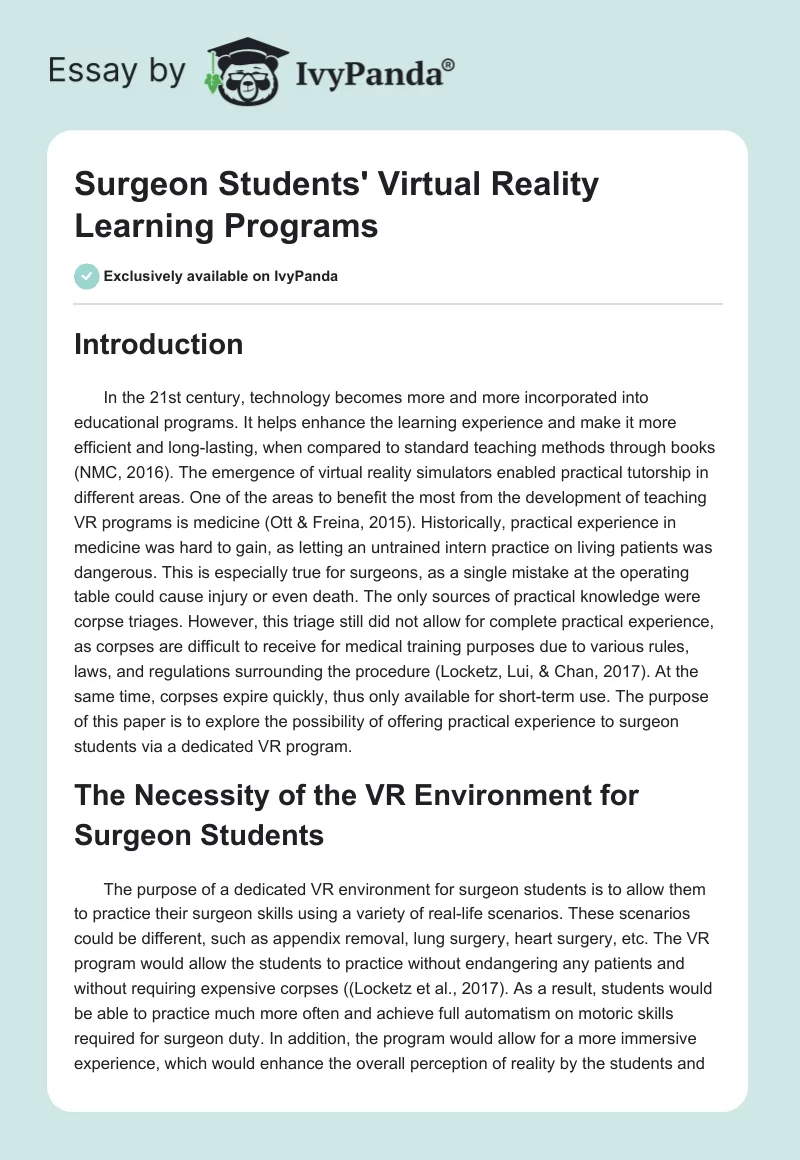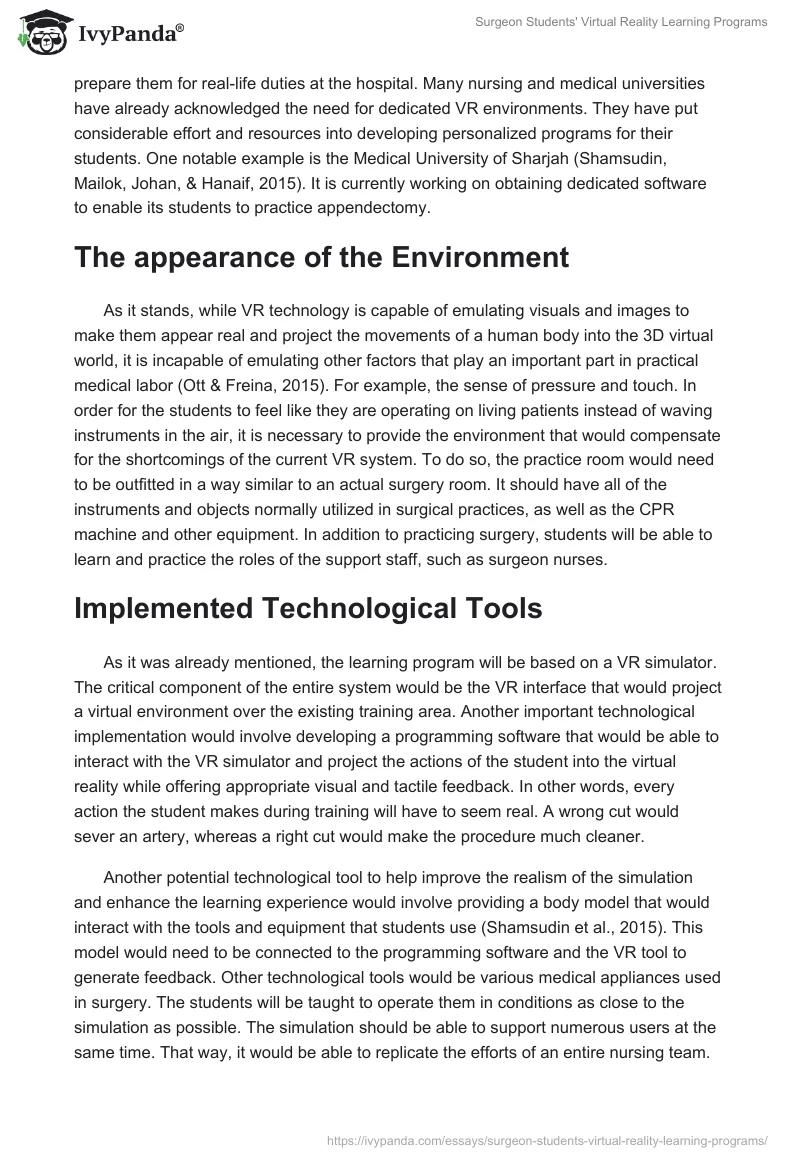Introduction
In the 21st century, technology becomes more and more incorporated into educational programs. It helps enhance the learning experience and make it more efficient and long-lasting, when compared to standard teaching methods through books (NMC, 2016). The emergence of virtual reality simulators enabled practical tutorship in different areas. One of the areas to benefit the most from the development of teaching VR programs is medicine (Ott & Freina, 2015). Historically, practical experience in medicine was hard to gain, as letting an untrained intern practice on living patients was dangerous. This is especially true for surgeons, as a single mistake at the operating table could cause injury or even death. The only sources of practical knowledge were corpse triages. However, this triage still did not allow for complete practical experience, as corpses are difficult to receive for medical training purposes due to various rules, laws, and regulations surrounding the procedure (Locketz, Lui, & Chan, 2017). At the same time, corpses expire quickly, thus only available for short-term use. The purpose of this paper is to explore the possibility of offering practical experience to surgeon students via a dedicated VR program.
The Necessity of the VR Environment for Surgeon Students
The purpose of a dedicated VR environment for surgeon students is to allow them to practice their surgeon skills using a variety of real-life scenarios. These scenarios could be different, such as appendix removal, lung surgery, heart surgery, etc. The VR program would allow the students to practice without endangering any patients and without requiring expensive corpses ((Locketz et al., 2017). As a result, students would be able to practice much more often and achieve full automatism on motoric skills required for surgeon duty. In addition, the program would allow for a more immersive experience, which would enhance the overall perception of reality by the students and prepare them for real-life duties at the hospital. Many nursing and medical universities have already acknowledged the need for dedicated VR environments. They have put considerable effort and resources into developing personalized programs for their students. One notable example is the Medical University of Sharjah (Shamsudin, Mailok, Johan, & Hanaif, 2015). It is currently working on obtaining dedicated software to enable its students to practice appendectomy.
The appearance of the Environment
As it stands, while VR technology is capable of emulating visuals and images to make them appear real and project the movements of a human body into the 3D virtual world, it is incapable of emulating other factors that play an important part in practical medical labor (Ott & Freina, 2015). For example, the sense of pressure and touch. In order for the students to feel like they are operating on living patients instead of waving instruments in the air, it is necessary to provide the environment that would compensate for the shortcomings of the current VR system. To do so, the practice room would need to be outfitted in a way similar to an actual surgery room. It should have all of the instruments and objects normally utilized in surgical practices, as well as the CPR machine and other equipment. In addition to practicing surgery, students will be able to learn and practice the roles of the support staff, such as surgeon nurses.
Implemented Technological Tools
As it was already mentioned, the learning program will be based on a VR simulator. The critical component of the entire system would be the VR interface that would project a virtual environment over the existing training area. Another important technological implementation would involve developing a programming software that would be able to interact with the VR simulator and project the actions of the student into the virtual reality while offering appropriate visual and tactile feedback. In other words, every action the student makes during training will have to seem real. A wrong cut would sever an artery, whereas a right cut would make the procedure much cleaner.
Another potential technological tool to help improve the realism of the simulation and enhance the learning experience would involve providing a body model that would interact with the tools and equipment that students use (Shamsudin et al., 2015). This model would need to be connected to the programming software and the VR tool to generate feedback. Other technological tools would be various medical appliances used in surgery. The students will be taught to operate them in conditions as close to the simulation as possible. The simulation should be able to support numerous users at the same time. That way, it would be able to replicate the efforts of an entire nursing team. The software should provide plenty of potential scenarios. Some of them would include emergency surgeries, staple surgeries (appendectomy), and others (Shamsudin et al., 2015). The tools used by the students should also have a means of connecting with the main processing unit in order to generate feedback accurately.
The Role of the Instructor during the Learning Process
During the VR simulation, the instructor would take the role of an expert. In order to control the actions of the students, the instructor could either take part in the simulation personally or survey the actions of all students via a screen that shows the actions of every individual participant from different camera angles. The former method is good for initiation and hands-on instructions, as the teacher would be able to present the proper way of performing operations for students. The latter is excellent for analyzing individual performance and providing feedback on their efforts. Teaching methods involved in VR simulation are as follows (Spector, Merrill, Elen, & Bishop, 2013):
- The Demonstration Method – the teacher, demonstrates the proper ways of execution of various surgical techniques and explains the rationale behind them.
- The Roleplaying Method – the students participating in the VR simulation would take on the role of surgeons and surgeon aides in order to perform an operation in a virtual environment.
Skills Learned through VR Environment
The potential for learning through a dedicated surgeon VR module is enormous. The students will be able to practice motoric skills while performing a practice surgery, improve their identification of various signs and symptoms, improve decision-making skills, learn to work as part of a surgical team, and familiarize themselves with all the required practices and procedures in an environment very close to reality (Nicholls, Sweet, Muller, & Hyett, 2016). While VR, with its current technological limitations, cannot fully recreate the experience of a real surgery, which involves not only the accuracy of images and sounds, but also scents and tactile manifestations, it will provide the students with the necessary practical learning experience, which many surgeon students often lack upon finishing their university studies. It will enable the preparation of qualified surgeon cadres much quicker, which should improve knowledge levels and the overall quality of care.
References
Locketz, G. D., Lui, J. T., & Chan, S. (2017). Anatomy-specific virtual reality simulation in temporal bone dissection: Perceived utility and impact on surgeon confidence. Otolaryngology – Head and Neck Surgery, 156(6), 1142-1149.
Nicholls, D., Sweet, L., Muller, A., & Hyett, J. (2016). Teaching psychomotor skills in the twenty-first century: Revisiting and reviewing instructional approaches through the lens of contemporary literature. Medical Teacher, 38(10), 1056-1063.
NMC. (2016). The NMC/CoSN Horizon Report: 2016 K-12 Edition. Web.
Ott, M., & Freina, L. (2015). A literature review on immersive virtual reality in education: State of the art and perspectives. Editura Universităţii Naţionale de Apărare „Carol I, 2015(1), 133-141.
Shamsudin, C. S. S. K., Mailok, R., Johan, R., & Hanaif, H. F. (2015). The development and evaluation of a 3D visualization tool in anatomy education. EDUCATUM – Journal of Science, Mathematics, and Technology, 2(2), 48-56.
Spector, J. M., Merrill, M. D., Elen, J., & Bishop, M.J., (2013). Handbook of Research on Educational Communications and Technology. New York, NY: Springer.


